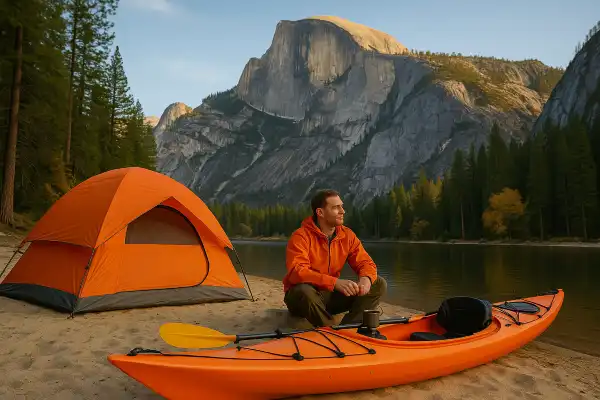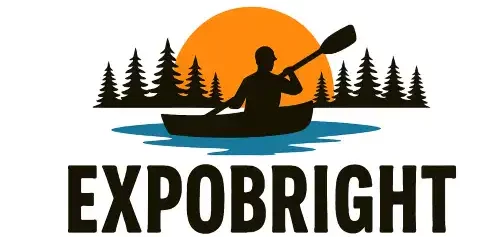Where can you kayak camp in California? The question surfaces every time paddlers scan maps of the Golden State, dreaming of nights spent beneath star-filled skies after days exploring hidden coves and pristine waterways. California’s diverse geography creates endless opportunities for combining paddling with camping, from alpine lakes nestled in granite bowls to coastal sanctuaries where sea lions bark lullabies.
My first kayak camping experience in California happened on a windless evening at Emerald Bay, watching the last tourist boats disappear around the granite headlands. That night taught me something profound: California doesn’t just offer kayak camping – it perfects it. The state’s 1,350 kilometers of coastline, thousands of alpine lakes, and meandering rivers create a paddler’s paradise where every stroke leads toward adventure.
Must read for your safety when kayak camping: How to get rid of spider in a kayak?
Where can you kayak camp in California?
California offers exceptional kayak camping opportunities across three distinct regions: alpine lakes in the Sierra Nevada mountains, coastal marine sanctuaries along the Pacific, and protected river systems throughout the state. Each location provides unique paddling experiences with designated camping areas accessible only by watercraft.

Sierra Nevada Mountain Lakes
The Sierra Nevada range transforms kayak camping into an alpine adventure. Cherry Lake sits just outside Yosemite, less than 4 hours from San Francisco, offering granite walls reminiscent of Yosemite without the crowds. Cherry Lake is lower elevation than most Sierra lakes which makes it a great destination for early season paddling, and wilderness permits allow camping without National Park restrictions.

Lake Tahoe provides the crown jewel of Sierra kayak camping through Emerald Bay’s boat-in campground. Twenty sites occupy the north side of Emerald Bay, with three waterfront sites offering private beaches. You can launch from Lester Beach in DL Bliss State Park or Baldwin Beach, then paddle 4-5 miles along the shore parallel to the famous Rubicon Trail. Reservations are required six months in advance, making advance planning essential.
Union Valley Reservoir in the Tahoe National Forest offers multiple campground options including Camino Cove, Yellow Jacket, Wench Creek, and Sunset. The reservoir features sandy beaches ideal for launching kayaks and exploring protected coves. Gold Lake, located at 6,400 feet elevation near Graeagle, provides access to over 20 small lakes connected by hiking trails, creating opportunities for multi-day exploration.
Englebright Reservoir offers one hundred boat-in campsites at seventeen campground areas along its nine-mile length. The upper section above Upper Boston prohibits water skiing, ensuring peaceful paddling conditions. The reservoir operates year-round with running lights for night navigation.
Channel Islands Marine Sanctuaries
Channel Islands National Park provides pristine kayak camping at Santa Cruz Island’s Scorpion campground and Santa Barbara Island’s clifftop sites. Santa Cruz Scorpion campground requires ferry transportation from Ventura Harbor, with camping split between Upper and Lower loops approximately half a mile from the dock.

The crystal clear Pacific waters around Scorpion Anchorage offer world-class sea cave exploration and kelp forest paddling. Sandy and cobblestone beaches provide easy kayak launches, while stunning sea caves and hidden coves create perfect exploration opportunities.
Santa Barbara Island offers ten primitive campsites perched on bluffs 200 feet above Landing Cove. The quarter-mile hike from landing to campground includes a 200-foot climb, but rewards campers with magnificent coastal views. This smallest Channel Island spans just one square mile, making it perfect for comprehensive exploration.
Catalina Island provides multiple boat-in camping options accessible only by kayak, offering secluded beaches and world-renowned snorkeling. The island’s protected coves create ideal conditions for beginning sea kayakers while offering challenges for experienced paddlers.
Coastal River Systems and Estuaries
Mendocino County’s “Lost Coast” offers epic and uncrowded paddling along wild, undeveloped coastline inaccessible from major highways. The Noyo River provides calm water frequented by sea lions, harbor seals and river otters, with multiple camping options in the area.
Big River, California’s longest undeveloped estuary, offers eight tidal miles surrounded by California State Park lands. The protected waterway provides excellent wildlife viewing and connects to various camping areas along the Mendocino Coast.
Tomales Bay features nighttime bioluminescence tours and private overnight camping adventures for groups of six or more, creating magical experiences combining paddling with unique natural phenomena.
Central California River Adventures
The Colorado River section from Needles to Squaw Lake Recreation Area offers a 76-mile journey through State Park land with plentiful wildlife and historical sites. The trip breaks into a four-day adventure with stops at Mohave Wash (three free, first-come-first-serve sites) and Walter’s Camp (reserve-ahead paid site).
San Joaquin River’s section from Squaw Leap features wide, slow water with many curves, lined with trees and visible green hills. The 40-mile route includes Class I water perfect for leisurely kayak camping, with interpretive sites offering glimpses into California’s settlement history.
Planning Considerations
Most alpine locations require wilderness permits and advance reservations. California State Parks campgrounds can be reserved at reservecalifornia.com, while Forest Service campgrounds use recreation.gov. Channel Islands camping requires coordination with Island Packers for ferry transportation, and all gear must be carried from landing areas to campsites.
Weather patterns vary dramatically across California’s kayak camping destinations. Sierra locations offer optimal conditions from late spring through early fall, while coastal areas provide year-round opportunities with varying seasonal conditions. September and early October often provide the best combination of warm weather and reduced crowds.
Conclusion
Last September, I paddled into a protected cove on Santa Cruz Island as golden hour painted the Channel Islands in amber light. Setting up camp steps from my kayak, surrounded by nothing but sea lion conversations and gentle waves, reminded me why California stands alone for waterway adventures. The difference between randomly choosing a camping spot and following a well-researched guide becomes crystal clear when you’re watching sunrise from your tent door, knowing you’ve discovered one of the state’s hidden gems. Whether you’re drawn to granite-walled alpine lakes or sea cave exploration, California’s kayak camping destinations reward prepared paddlers with experiences that linger long after the last paddle stroke.
Follow Expobright for exclusive kayak and canoe camping tips.
